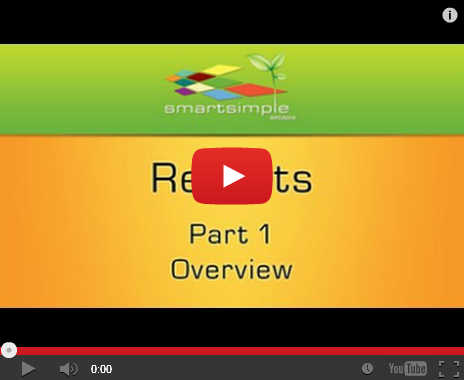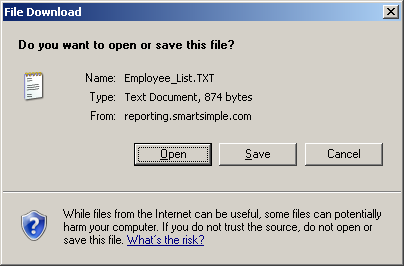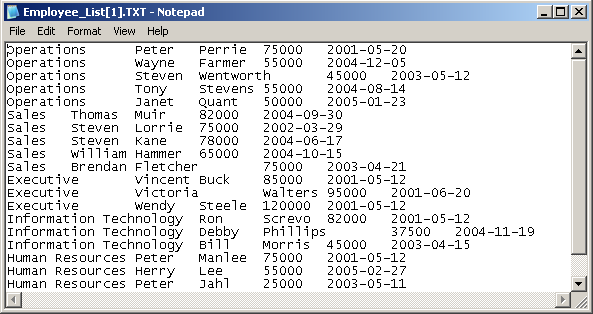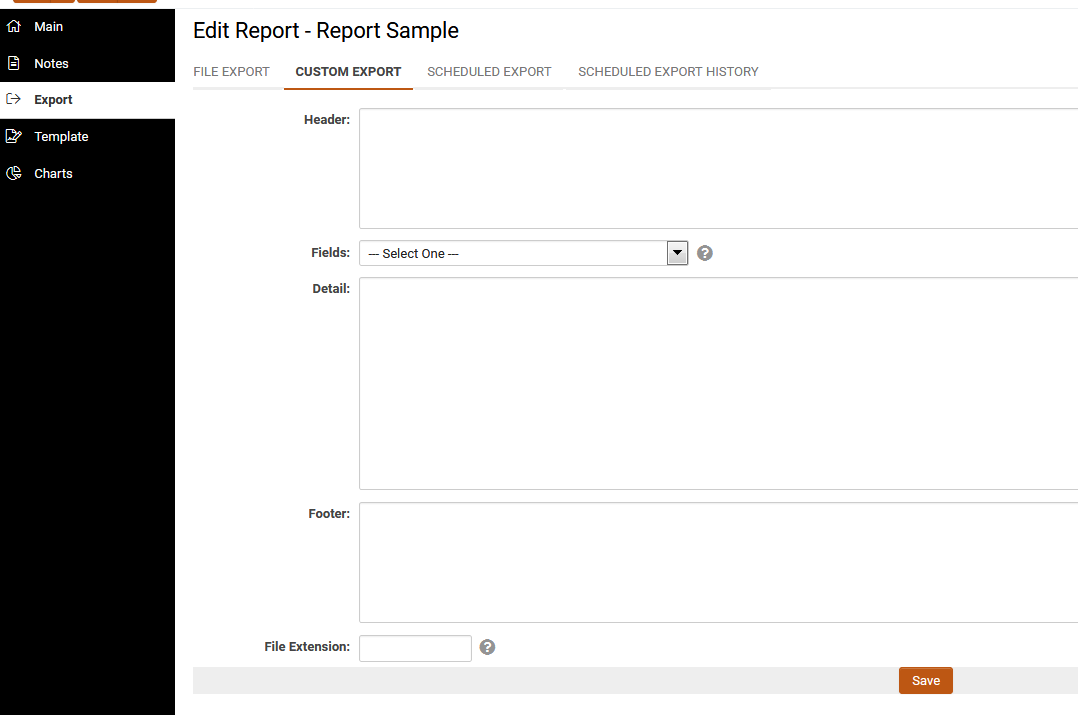Difference between revisions of "Exporting Reports"
(→File Extension) |
(→Examples) |
||
| Line 205: | Line 205: | ||
===Examples=== | ===Examples=== | ||
| − | + | ||
:*:* Export Every Monday of the week @ 0900 | :*:* Export Every Monday of the week @ 0900 | ||
:*:: Choose a future date that falls on a Monday for the '''Start Date''', '''Weekly''' for the '''Frequency''' and select the '''Time of Export''' dropdown list. | :*:: Choose a future date that falls on a Monday for the '''Start Date''', '''Weekly''' for the '''Frequency''' and select the '''Time of Export''' dropdown list. | ||
Revision as of 16:02, 13 February 2020
Contents
Overview

There are two techniques to access report data from other applications.
- If you want to access reports from Microsoft Excel or Microsoft Word, then you can use the SmartSimple Plug-Ins for Microsoft Office for these applications to access report data.
- See Plug-Ins for Microsoft Office for details
This article explains how to use the 2nd method, which is exporting.
- If you want to export the report data to any other data format (for example comma separated values), then you can use the Export settings for the report to create the file format required.
- You can also use this technique to create a MS-Excel or MS-Word file, without the need to use the Plug-In application.
File Export
File Extension
A report can be exported into a flat file with the following file extension:
- txt – Windows Notepad.
- xls – Microsoft Excel.
- iif – QuickBooks.
- csv - Comma Separated Values.
- xml - Extensible Markup Language (can be opened in Notepad).
1. Set the Extension to txt.
The extension txt is generally associated with Notepad.
2. Click the Save button.
3. Click the Edit Report button.
4. Click the Reports tab.
The report list is displayed and the Employee list report is now displayed with an Export button.
5. Click the Export button.
Depending on your Browser and Security setting, you may need to answer some prompts before the file can be opened.
6. If required, click the Open button.
The file is opened in the associated application – Notepad.
The file name is set to the report name plus the extension specified.
7. Close the Notepad application.
IMPORTANT: In order to support special characters such as French accented letters, euro symbols etc SmartSimple uses UTF-8 encoding. When opening exported files Microsoft Excel always imports using ASCII, so special characters do not appear correctly. This is a flaw with Excel. In order to export data containing special characters to Excel use one of the procedures outlined on the Exporting Reports with Special Characters to Excel article.
Note: If the report has sub reports attached then you must set up the Custom Export settings for each of the sub report attached.
Export to XML
If you change the File extension to xml, then the report will construct an XML document from the report results.
1. In the Header section enter the XML declaration and open the root element, details:
<!--?xml version="1.0" encoding="ISO-8859-1"?-->{BREAK}
<details>{BREAK}
2. In the Detail section add the child elements, in the sample below the child is employee with subchildren firstname, lastname, salary and startdate.
The {TAB}s and {BREAK}s will give the XML document proper indentation:
{TAB}<employee>{BREAK}
{TAB}{TAB}<firstname>@Users - First name@</firstname>{BREAK}
{TAB}{TAB}<lastname>@Users - Last name@</lastname>{BREAK}
{TAB}{TAB}<salary>@Users - Salary@</salary>{BREAK}
{TAB}{TAB}<startdate>@Users - Start Date@</startdate>{BREAK}
{TAB}</employee>{BREAK}
3. In the Footer section, close the root element:
</details>
4. The Export XML document opened in Notepad:
<?xml version="1.0" encoding="ISO-8859-1"?> <details> <employee> <firstname>Peter</firstname> <lastname>Jahl</lastname> <salary>25000</salary> <startdate>11/05/2003</startdate> </employee> <employee> <firstname>Herry</firstname> <lastname>Lee</lastname> <salary>55000</salary> <startdate>27/02/2005</startdate> </employee> <employee> <firstname>Peter</firstname> <lastname>Manlee</lastname> <salary>75000</salary> <startdate>12/05/2001</startdate> </employee> </details>
Exporting with Subreports
In order to export a report that contains subreports or merged reports you must define the Advanced Export Settings for the subreports, as well as the main report. Example:
- The following would export a report and subreport in Comma Separated Values format (CSV):
@Companies/Accounts - Company name@,
@Companies/Accounts - Address 1@,
@Companies/Accounts - City@,
@Companies/Accounts - State@,
@Companies/Accounts - Company ID@,
@subreport_0@
{BREAK}
Custom Export
- Click the Custom Export tab (formerly Advanced Export Settings).
The Custom Export window is displayed.
This window consists of the following settings:
- Header - Static or variables that you need to display at the top of the export file.
- Fields - A list of fields taken from the report that is being used to create the report. In addition, you can select two special settings – {tab} – used to add a tab character to the specification and {break} – used to add a line feed to the specification.
- Detail - You construct the actual record layout for the specification in this area. This section can consist of multiple lines.
- Footer - Static or variables that you need to display at the bottom of the export file.
- File Extension - The extension that you wish to associate with the export specifications. By setting this value to any valid Windows file extension, the appropriate application will be launched when the data is exported.
Other settings:
- Delimiter - tab character ({TAB}), comma, semi-colon, colon
- Line breaks - use either a UNIX line break ({LINEFEED}) or a Windows line break ({BREAK})
- Aggregate Functions in Header or Footer
- COUNT - count the total rows per report. @COUNT(column_name)@
- SUM - sum of a column in the report. @SUM(column_name)@
Export to SmartFolder or SFTP
A report can now be automated to export to a SmartFolder or an external SFTP site. You can now schedule a recurring task on a daily, weekly, or monthly basis to automatically run a report and export the contents. The file will be exported based the normal File Export' and no option for Custom Export is currently available.
From the report configuration, go to FILE EXPORT tab and under Scheduled Export, configure desired settings:
- Export Type - specify the type of export for the scheduled export
- Options:
- File Export - export file based on settings from [wiki/Exporting_Reports File Export] tab
- Custom Export - export file based on settings from [wiki/Custom_Export Custom Export]
- Frequency - choose the frequency of the export
- Disabled
- Daily
- Weekly
- Monthly
- Quarterly
- Yearly
- On Demand - used when report is linked to an autoloader.
At (Start Date) - specify time for the scheduled export Starting - specify the start date for the scheduled export
- Export To - select where to export the file
- SFTP
- URL - enter the url of the sftp site
- Username - username to allow access to the sftp
- Password - password to allow access to the sftp
- Path - sftp folder location where the files will be pushed i.e. /in or /out
- SFTP
- Export To - select where to export the file
Configuration Folder SmartFolder
- SmartFolder - select the SmartFolder where the files will be pushed
Update Status After Export - status of the records will changed to the selected status after export. Trigger Workflow After Export - workflow selected will be triggered to all records after export.
- Export File Name - file name of the file can be specified including stamp date. It is recommended to append a timestamp. To stamp the date, use [YYYY],[YY],[MM],[DD],[HH],[mm]. i.e. MyExportedReport_[YYYY]-[MM]-[DD]
- Last Exported - date and time of the last export.
Examples
- Export Every Monday of the week @ 0900
- Choose a future date that falls on a Monday for the Start Date, Weekly for the Frequency and select the Time of Export dropdown list.
-
- Export Every 15th of the month
- Choose 15th (future date) for the Start Date and Monthly for the Frequency and select the Time of Export dropdown list.
Troubleshooting
-
- This won't work for reports that have any criteria, or reports with any other variables that require a user session or user input - for instance, the setting that allows you to select a template from a SmartFolder before exporting. Reports violating these will either not be exported, or have no data when exported, or maybe some other unpredictable result.
- To reset/change the schedule, Disabled the Frequency then save it. This will delete the current setting configurations from the database. Then, enter new schedule settings and save.
- No option for Custom Export is currently available
-
See Also
 Creating a Dashboard to Display a Set of Charts
Creating a Dashboard to Display a Set of Charts
Back to Reports Category 




